Regardless of whether you're launching a new website, planning a meeting, or building a factory, you'll need to focus on organization. To do any of the above, it's necessary to have a framework.
Even simple projects can often be more complex than they seem: New challenges, deadlines that approaching too swiftly, or cost overruns are just a part of most project's lives.
A work breakdown structure helps to coordinate and balance these three criteria, otherwise known in project management as the magic triangle.
In this article, we'll let you know what a work breakdown structure is capable of, which advantages and disadvantages it has, and how it's designed.
What Is a Work Breakdown Structure?
A work breakdown structure (or WBS) is nothing more than the organization of a project into smaller, individual elements. Its goal is to categorize all parts of a project into manageable tasks and work packages.
Work breakdown structures are often visualized with tree diagrams, however, indented textual levels are also possible. When the latter is used, the result looks like a book's table of contents.
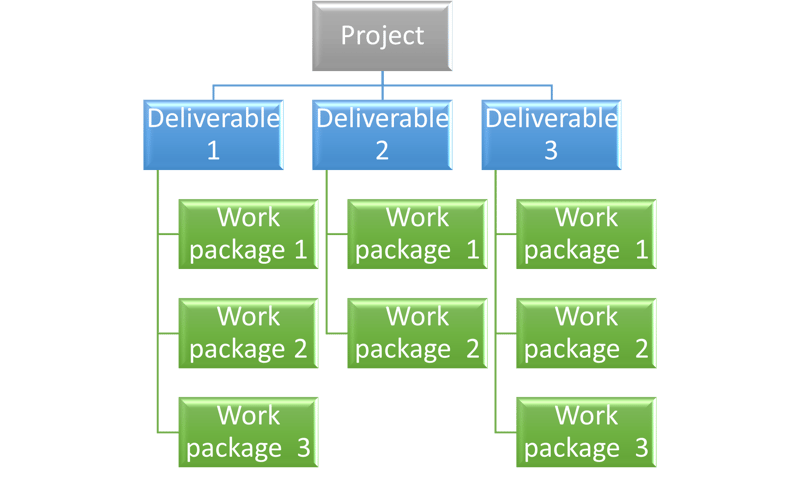
Work breakdown structures are commonly visualized with tree diagrams.
The textual approach is also preferred in software-based project management tools like Microsoft Project. Regardless of which diagram you use, make sure that the project can be readily understood.
Advantages and Disadvantages of a Work Breakdown Structure
A comprehensive work breakdown structure has something to offer every project and can be used as a checklist. It's particularly useful since it:
Summarizes all tasks relating to the project (including its management)
Differentiates tasks from one another
Provides clarity about how assignments are delegated
Offers an overview of the resources required
Gives insight into a project's costs
Can help answer questions when they arise
Prevents misunderstandings
Helps to reach a consensus about the project's goals
Of course, creating a WBS also takes time and consumes personnel resources. Beyond that though, there aren't many disadvantages.
Selecting a Work Breakdown Structure
To be as effective as possible, your work breakdown structure should fit on a single page. It's not desirable to go into too much detail. You'll also want to set aside enough time to prepare it.
Even though it makes sense to identify a project's structure early on, it takes time to understand dependencies and details.
In addition, a work breakdown structure should consist of a maximum of 10 phases. If you need more phases than that, you might want to consider dividing the project into multiple projects.
There are many different work breakdown structure plans, however, these are the three main types:
Deliverable-Oriented Work Breakdown Structure
A deliver-oriented (or object-oriented) WBS focuses on the project's result. For example, if you're developing a piece of software, its aspects will dictate what the WBS looks like.
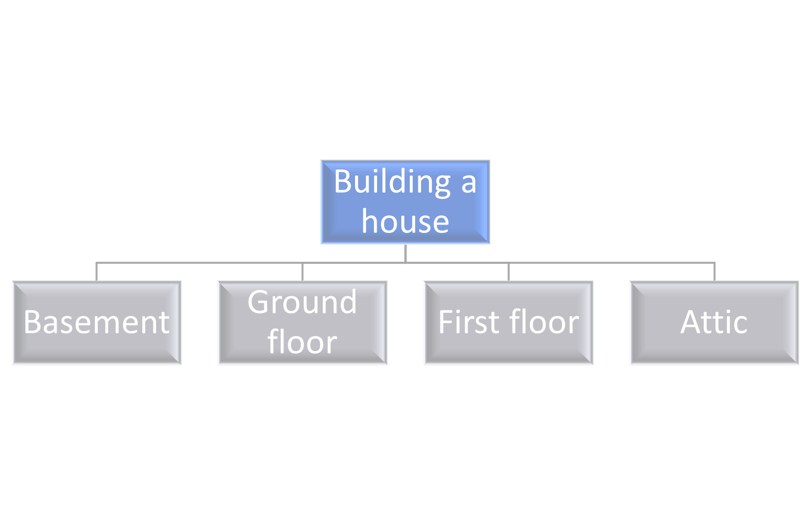
For an object-oriented WBS, the project is broken down into individual components.
If you were building a house, the completion of individual floors or even rooms might be the subcomponents. As each of these is finished, the project nears its goal.
Process-Oriented Work Breakdown Structure
This type of breakdown structure focuses on the processes and responsibilities. Here, it's less about the amount of time or result, but rather, about identifying which individual features contribute to the project.
If we stick with the house example from above, a process-oriented breakdown structure would emphasize finding suitable craftsmen and laborers for each of the requirements:
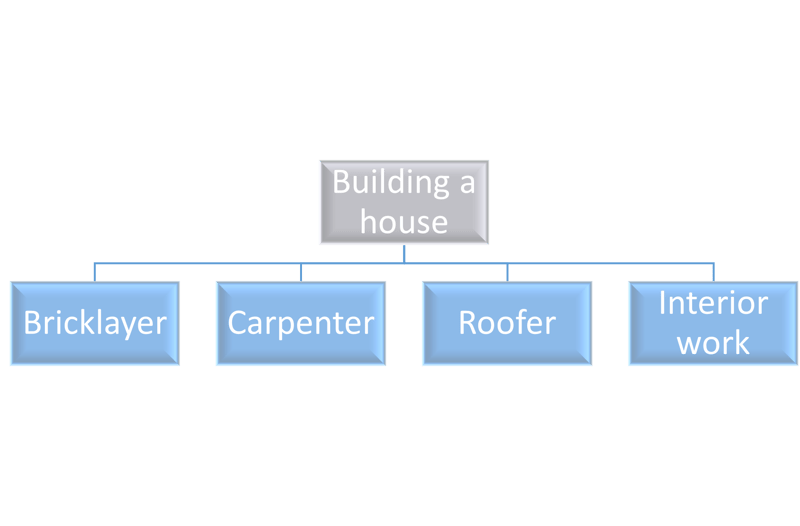
For the process-oriented breakdown structure, capabilities are at the center of attention.
Phase-Oriented Work Breakdown Structure
Phase-oriented breakdown structures are all about time. This method chronologically organizes projects into different phases that build upon one another.
Individual tasks are completed during specific phases. This makes it possible to quickly see time-based dependencies between tasks.
Since many projects are complex and intertwined, being able to see dependencies in the work breakdown structure helps to better understand them.
At the same time, this also makes it possible to see upstream and downstream activities in scheduling.
In the house-building example, the basement might be the first phase, followed by the floors, and then the roof. Different work projects are completed during the individual phases.
Creating a Work Breakdown Structure
A professional work breakdown structure should be a team effort. The management's abilities are complemented by the team's subject matter knowledge:
Management pays attention to the amount of time, money, and resources that are expended. The team handles topical matters and provides input about individual work packages and their execution.
There are three ways to create a work breakdown structure:
Top-Down: The Deductive Approach
Working from the top down proceeds from the big picture to the details. This is also referred to as the deductive approach. In this, a project is broken down into individual work packages.
This method works particularly well if you've completed similar projects in the past, or if the individual project steps are known and familiar.
The following steps might be part of a top-down approach:
- 1.
Name the project
- 2.
Break the project down into subprojects
- 3.
List all tasks within the subprojects
- 4.
Deconstruct all tasks until all work packages are ready
- 5.
Assign tasks and responsibilities
- 6.
Specify the timeframe and individual work packages
- 7.
Create an overall plan
Bottom-Up: The Inductive Approach
The bottom-up or inductive approach proceeds in the opposite way as the top-down approach. This method starts from details and works up to the big picture. The completion of individual tasks builds up to the overall project.
The following steps are common:
- 1.
Identify all individual tasks for a project. Try brainstorming among the involved departments
- 2.
Establish relationships and dependencies between individual tasks
- 3.
Create a WBS (a tree diagram, for example)
- 4.
Check that all tasks are included
- 5.
Define responsibilities
- 6.
Specify the timeframe
- 7.
Finalize the overall plan
The bottom-up approach is suitable for any kind of project that has a unique character or relies on innovation. Individual tasks typically aren't clear from the outset, and can't be set by management.
Since this type of breakdown structure relies on expert knowledge, they must be involved in the creation of assignments.
Even if it's challenging to identify all tasks at the beginning, the WBS should be as complete as possible. This is important since it helps to plan resource allocation and processes over time.
The Hybrid Form: Combining the Inductive and Deductive Approaches
Some projects benefit from a combination of the inductive and deductive approaches. Thankfully, it's possible to take advantage of the benefits each offers.
This is known as the Yo-Yo approach: You'll alternate between both approaches and plan the project, first deductively, before you inductively check your analysis.
The completeness of the tasks and their uniqueness are always in the foreground, even with this mixed form.
Work Breakdown Structure Examples
Launching a business website offers an excellent opportunity to use a work breakdown structure since it's a one-time undertaking.
In our example, the "Website launch" project is broken down into five phases, each of which contains additional work packages:
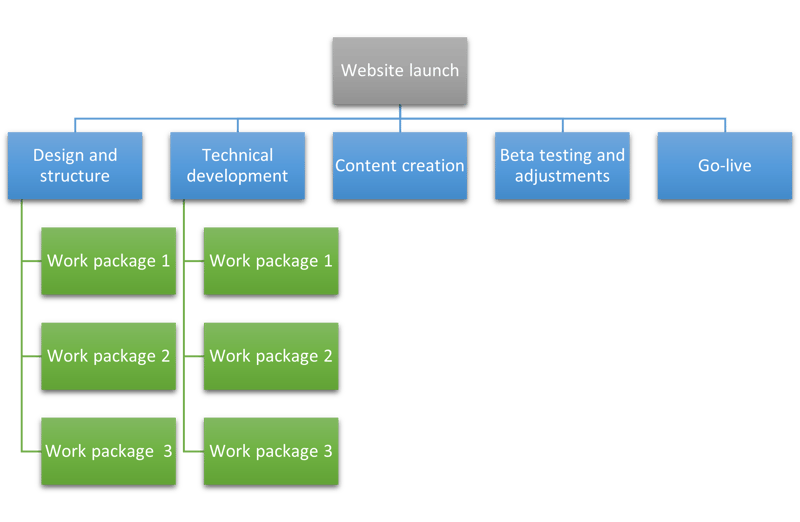
The phases above are further divided into additional work packages.
The above example is a phase-oriented work breakdown structure in which each phase builds on the next. Additional work packages can be assigned to phases and completed accordingly.
With this overview, it becomes clear that there are various work packages. However, the extent of these is not visible. Developing a website usually requires many more resources than going live.
Nevertheless, all work packages are separate and differentiated from one another. This makes it easy to allocate resources towards their completion, which in turn, allows the project to move from phase to phase.
If you were to design a process-oriented work breakdown structure for the same project, it might look like this:
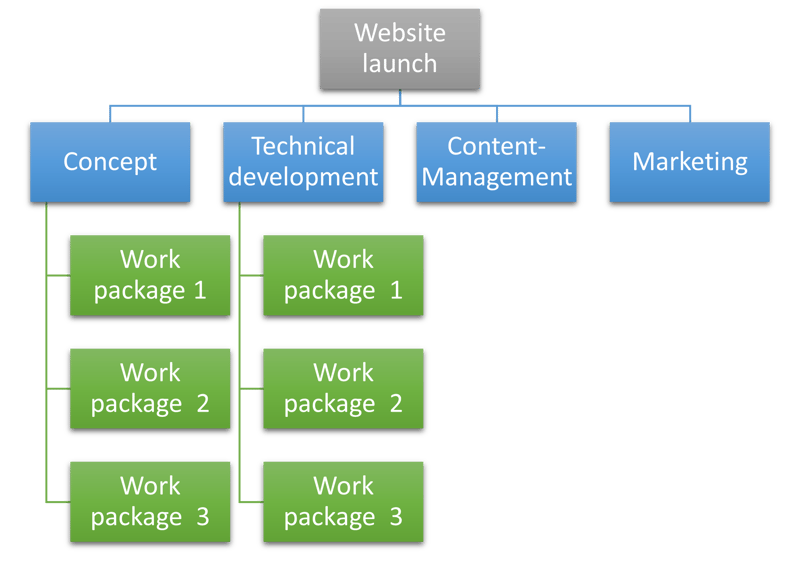
Projects can be visualized differently, depending on their structure.
Conclusion
A work breakdown structure helps to subdivide comprehensive undertakings into smaller, easily distinguishable work packages. These can then be assigned to project members and teams for completion.
This approach helps to keep projects within time, financial, and qualitative limits. Within a project, a breakdown structure can be the central element for planning and communication.
Depending on the type of project, a WBS can be phase-oriented, process-oriented, or deliverable-oriented. Apart from that, there are top-down, bottom-up, and hybrid approaches.
The ideal form and method will vary from project to project.












